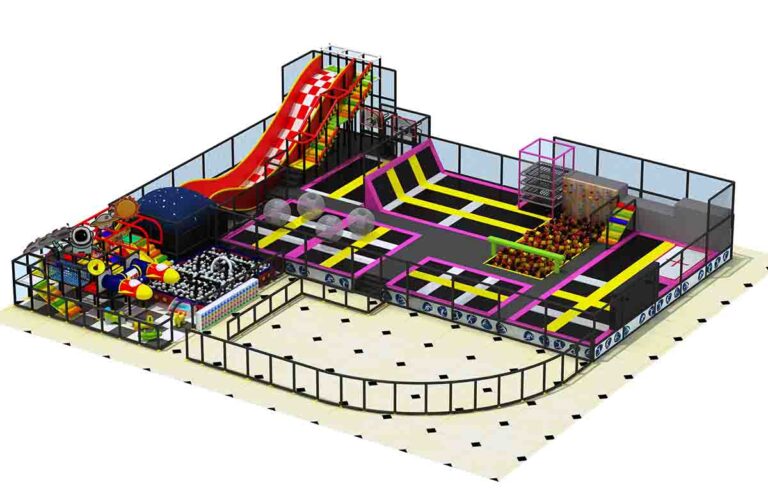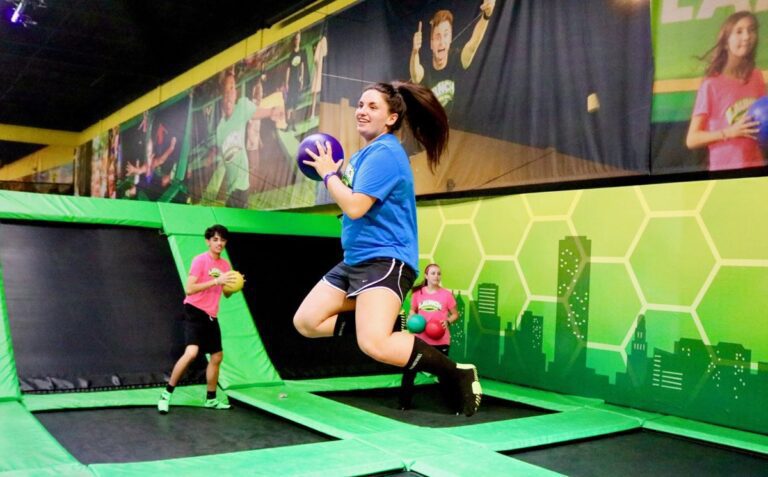Jumping Techniques: Mastering the Art of Trampolining at Indoor Parks
Introduction
What is trampolining?
Trampolining is a thrilling and dynamic sport that involves performing various acrobatic movements on a trampoline. It combines elements of gymnastics, tumbling, and aerial stunts, making it an exciting activity for people of all ages and skill levels. Trampolining provides a unique opportunity to defy gravity and experience the exhilaration of soaring through the air. Whether it’s bouncing high into the sky, executing flips and twists, or perfecting intricate routines, trampolining offers a fun and challenging way to improve balance, coordination, and overall fitness. Indoor parks dedicated to trampolining provide a safe and controlled environment for enthusiasts to practice and showcase their skills, making it an ideal place to learn and master the art of trampolining.
Benefits of trampolining
Trampolining offers a multitude of benefits that go beyond just having fun. One of the key advantages is its ability to improve cardiovascular health. Jumping on a trampoline increases the heart rate, promoting better blood circulation and strengthening the heart muscle. Additionally, trampolining is a great way to enhance coordination and balance. The constant bouncing requires precise movements and body control, which helps to improve overall motor skills. Moreover, trampolining is a low-impact exercise that puts less strain on the joints compared to other activities like running or jumping on hard surfaces. This makes it an ideal option for individuals of all ages and fitness levels, providing a safe and enjoyable way to stay active.
Indoor parks: The perfect trampolining destination
Indoor parks are the ultimate trampolining destination for enthusiasts of all ages. These parks offer a safe and controlled environment for individuals to practice and perfect their jumping techniques. With a wide range of trampolines and various jumping areas, indoor parks provide endless opportunities for thrill-seekers to explore their acrobatic skills. Whether you are a beginner or an experienced trampolinist, these parks cater to all levels of expertise, ensuring a fun and exhilarating experience for everyone. Additionally, the indoor setting allows for year-round trampolining, regardless of weather conditions, making it a convenient option for those seeking an adrenaline rush at any time. So, if you are looking to master the art of trampolining, indoor parks are the ideal destination to unleash your inner jumper and soar to new heights.
Basic Jumping Techniques
Proper body positioning
Proper body positioning is crucial for mastering the art of trampolining at indoor parks. When jumping on a trampoline, it is important to maintain a straight and upright posture. This means keeping your head up, shoulders back, and chest out. By doing so, you can ensure better balance and control while in the air. Additionally, it is essential to engage your core muscles and keep them tight throughout the jump. This will help stabilize your body and prevent any unnecessary movements that may throw off your balance. Remember to also keep your arms relaxed and slightly bent at the elbows, allowing them to move naturally with your body. By practicing proper body positioning, you can enhance your trampolining skills and perform more advanced techniques with ease.
Bouncing technique
Bouncing technique is a crucial aspect of mastering the art of trampolining at indoor parks. To achieve maximum height and control, it is important to focus on proper body positioning and timing. The key to a successful bounce lies in using the legs and core muscles to generate power and momentum. As you descend towards the trampoline, bend your knees slightly and engage your core muscles. Then, as you spring back up, extend your legs and push off the trampoline surface with force. It is essential to maintain a balanced and centered position throughout the bounce, keeping your body aligned and your eyes focused ahead. By practicing and refining your bouncing technique, you can enhance your trampolining skills and experience the exhilaration of soaring through the air with grace and precision.
Landing techniques
Landing techniques are crucial in trampolining as they ensure a safe and controlled descent after performing various jumps and flips. One important technique is to keep your body relaxed and absorb the impact by bending your knees upon landing. This helps to distribute the force evenly and reduces the risk of injury. Additionally, it is essential to maintain proper body alignment by keeping your head up and your back straight. This not only improves balance but also allows for a smoother landing. Another useful tip is to aim for the center of the trampoline when landing, as this area provides the most bounce and stability. By practicing and mastering these landing techniques, trampolinists can enhance their overall performance and minimize the chances of accidents or mishaps.
Advanced Jumping Techniques
Front flips and backflips
Front flips and backflips are two of the most exhilarating and impressive moves in trampolining. These advanced techniques require a combination of skill, technique, and confidence. When performing a front flip, the key is to generate enough height and momentum by bouncing off the trampoline bed and tucking your knees towards your chest. As you reach the peak of your jump, initiate a forward rotation by extending your body and using your core muscles to control the movement. Landing safely requires spotting the trampoline bed and extending your legs to absorb the impact. On the other hand, executing a backflip involves a similar approach but with a different body position. As you bounce, initiate the rotation by tucking your knees towards your chest and leaning backward. Spotting the trampoline bed during the rotation is crucial to maintain control and ensure a smooth landing. It is important to note that both front flips and backflips should only be attempted by experienced trampolinists under the supervision of a trained instructor.
Twisting and spinning jumps
Twisting and spinning jumps are some of the most exhilarating and visually impressive techniques in trampolining. These jumps require a combination of skill, strength, and coordination to execute properly. When performing a twisting jump, the trampolinist uses their body to rotate in mid-air, creating a twisting motion. This can be done in various directions, such as a single twist, double twist, or even multiple twists. Spinning jumps, on the other hand, involve rotating the body horizontally while in the air. This can be achieved through techniques like the front or back somersaults, where the trampolinist tucks their body and performs a full rotation. Mastering these twisting and spinning jumps adds an extra level of excitement and complexity to trampolining routines, showcasing the athlete’s control and creativity in the air.
Combining multiple jumps
Combining multiple jumps is an advanced skill that trampolinists can master to create impressive and dynamic routines at indoor parks. By seamlessly transitioning from one jump to another, athletes can showcase their agility, creativity, and control in the air. One popular technique for combining jumps is known as the “double bounce.” This involves using the rebound from the trampoline to execute a second jump immediately after the first one, propelling the jumper even higher into the air. Another technique is called the “twist and tuck,” where the trampolinist performs a twist in mid-air while simultaneously tucking their body into a tight ball position. This adds a visually stunning element to the routine and can be combined with other jumps to create complex sequences. Mastering the art of combining multiple jumps requires practice, precision, and a deep understanding of body control, but the results can be truly breathtaking.
Safety Measures
Warming up and stretching
Warming up and stretching are crucial steps to prepare your body for trampolining at indoor parks. Before you start jumping, it is important to increase your heart rate and warm up your muscles to prevent injuries. Begin with a light jog or some jumping jacks to get your blood flowing and loosen up your joints. After the warm-up, focus on stretching your major muscle groups, such as your legs, arms, and back. This will help improve your flexibility and range of motion, allowing you to perform jumps and tricks more effectively. Remember to hold each stretch for at least 15-30 seconds and avoid bouncing while stretching, as it can lead to muscle strain. By dedicating time to warm up and stretch properly, you can enhance your trampolining experience and minimize the risk of injuries.
Using safety equipment
Using safety equipment is essential when participating in trampolining at indoor parks. These parks typically provide safety measures such as safety nets, padding, and harnesses to ensure the well-being of jumpers. Safety nets are installed around the trampolines to prevent jumpers from falling off and injuring themselves. The padding on the trampolines and surrounding areas helps to cushion any accidental falls or landings. Additionally, some parks offer harnesses that can be attached to jumpers to provide extra security and prevent them from bouncing too high or losing control. It is crucial for individuals to utilize these safety equipment options to minimize the risk of injuries and enjoy a safe and fun trampolining experience.
Avoiding risky maneuvers
When it comes to trampolining at indoor parks, it is crucial to prioritize safety and avoid risky maneuvers. While it may be tempting to attempt complex flips or tricks, it is important to remember that trampolines can be unpredictable and accidents can happen. To minimize the risk of injury, it is advisable to stick to basic jumping techniques and gradually progress to more advanced moves as skills and confidence improve. It is also essential to follow the rules and guidelines set by the indoor park, such as jumping within designated areas and avoiding overcrowded trampolines. By avoiding risky maneuvers and prioritizing safety, trampolining can be a fun and enjoyable activity for everyone.
Trampolining Tips and Tricks
Increasing jump height
Increasing jump height is a crucial skill to master in trampolining at indoor parks. To achieve greater height, it is essential to focus on proper technique and body positioning. One effective technique is to engage the core muscles and use them to generate power for the jump. By tightening the abdominal muscles and maintaining a straight posture, the body can efficiently transfer energy to the trampoline bed, resulting in a higher bounce. Additionally, timing plays a significant role in increasing jump height. Timing the jump with the downward motion of the trampoline bed allows for maximum upward propulsion. By practicing these techniques and refining body control, trampolinists can gradually improve their jump height and execute impressive aerial maneuvers.
Mastering different jump styles
Mastering different jump styles is essential for becoming a skilled trampolinist at indoor parks. There are various jump styles that can be learned and perfected to add flair and excitement to your trampolining routine. One popular jump style is the tuck jump, where you bring your knees up towards your chest while in mid-air. This jump style allows for greater control and maneuverability, enabling you to perform tricks and flips with ease. Another jump style is the pike jump, where you keep your legs straight and reach for your toes while airborne. This style emphasizes flexibility and body control, creating a visually stunning jump. Additionally, the straddle jump involves spreading your legs wide apart while jumping, showcasing your agility and coordination. By mastering these different jump styles, trampolinists can elevate their performance and create a captivating experience for themselves and their audience at indoor parks.
Improving coordination and balance
Improving coordination and balance is crucial for mastering the art of trampolining at indoor parks. Trampolining requires precise control of body movements and the ability to maintain balance while executing various jumps and flips. To enhance coordination, trampolinists can engage in exercises that focus on proprioception, such as standing on one leg or performing balance drills on unstable surfaces. Additionally, practicing basic trampoline skills, such as bouncing in a controlled manner and landing softly, can help improve coordination and body awareness. By honing these skills, trampolinists can enhance their overall performance and execute more advanced techniques with ease.
Common Mistakes to Avoid
Overestimating abilities
Overestimating abilities can be a common mistake when it comes to trampolining at indoor parks. Many individuals may feel confident in their jumping skills and attempt more advanced techniques without fully understanding the risks involved. This can lead to accidents and injuries, as the trampoline’s bounce can be unpredictable and difficult to control. It is important to remember that trampolining requires skill, practice, and proper technique. It is always advisable to start with basic jumps and gradually progress to more complex maneuvers as one becomes more comfortable and experienced. By acknowledging and respecting one’s limitations, trampoliners can ensure a safer and more enjoyable experience at indoor parks.
Neglecting proper technique
Neglecting proper technique while trampolining can lead to a variety of issues and potential injuries. Without focusing on the correct form and execution of jumps, individuals may find themselves landing awkwardly or off-balance, increasing the risk of sprains or strains. Additionally, improper technique can hinder progress and limit the ability to perform more advanced maneuvers. It is crucial to prioritize learning and mastering the proper jumping techniques to ensure a safe and enjoyable trampolining experience at indoor parks. By understanding and practicing correct form, individuals can enhance their skills, minimize the chances of injury, and fully appreciate the art of trampolining.
Ignoring safety guidelines
Ignoring safety guidelines while trampolining at indoor parks can have serious consequences. Trampolining is a fun and exhilarating activity, but it is important to remember that safety should always be a top priority. By disregarding safety guidelines, individuals put themselves at risk of injuries such as sprains, fractures, or even more severe accidents. These guidelines are in place for a reason, as they help ensure a safe and enjoyable experience for everyone. It is crucial to follow instructions regarding weight limits, proper jumping techniques, and the use of safety equipment such as harnesses or pads. Ignoring these guidelines not only endangers oneself but also poses a potential threat to others sharing the trampoline. Therefore, it is essential to always prioritize safety and adhere to the guidelines set forth by the indoor park to prevent any unnecessary accidents or injuries.







